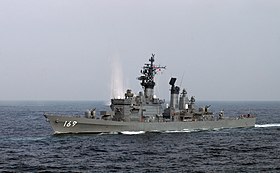Tachikaze class
|
|
|
|---|---|
| Tachikaze class | |
 Asakaze (DD-169) at the SDF Fleet Review 2006 |
|
| Overview | |
| Type | Guided missile destroyer |
| units | 3 |
| period of service |
1976 to 2010 |
| Technical specifications | |
| displacement |
3,850 tons (empty) |
| length |
143.0 meters |
| width |
14.3 meters |
| Draft |
4.6 meters |
| crew |
277 |
| drive |
2 × steam turbine |
| speed |
32 knots |
| Armament |
|
| Sensors | |
The Tachikaze class ( Japaneseた ち か ぜ 型 護衛艦, Tachikaze-gata goeikan ) was a class of three guided missile destroyers of the Japanese Sea Self-Defense Forces (JMSDF) .
General
The on in the seventies Mitsubishi - shipyard in Nagasaki developed and built Tachikaze class was the second generation of guided missile destroyers of the Marine Self-Defense Forces. The three ships followed the Amatsukaze built ten years earlier and the subsequent Hatakaze class is based on their design . Like them, their main task was to hunt submarines and protect a combat group from air raids .
The ships decommissioned between early 2007 and mid-2010 were replaced by two Atago-class guided missile destroyers .
units
| Identifier | Surname | Shipyard | Keel laying | Launch | Commissioning | Decommissioning | home port |
|---|---|---|---|---|---|---|---|
| DDG-168 | Tachikaze ( た ち か ぜ ) | MHI , Nagasaki | June 19, 1973 | 17th December 1974 | March 26, 1976 | January 15, 2007 |
Sasebo (1976–1995) Yokosuka (1995–2007) |
| DDG-169 | Asakaze ( あ さ か ぜ ) | May 27, 1976 | October 15, 1977 | March 27, 1979 | March 12, 2008 | Yokosuka (1979–1995) Sasebo (1995–2008) |
|
| DDG-170 | Sawakaze ( さ わ か ぜ ) | September 14, 1979 | 4th June 1981 | March 30, 1983 | June 25, 2010 | Sasebo (1983-2007) Yokosuka (2007-2010) |
technology
Hull and drive
The hull of a Tachikaze-class destroyer was 143 meters long, 14.3 meters wide and had a draft of 4.6 meters with a maximum displacement of 4,800 tons . The drive was carried out by two steam turbines from General Electric . These acted on two waves with a total output of 70,000 wave horsepower and enabled a top speed of 32 knots .
Armament
The main armament consisted of a rear-mounted Mk.13 launcher for standard missile anti-aircraft missiles , while RIM-24 Tartar were still fired and a Mk.112 launcher for anti-submarine missiles RUR-5 ASROC . This was together with one of the two Mark 42 guns in front of the bridge . The second gun was located aft, between the Mk.13 starter and the rear superstructure. The arming has been completed by two quad starter for RGM-84 Harpoon - anti-ship missiles , one each on the side befindliches pivotable triple torpedo tube and two phalanx - short range defense systems .
electronics
Mainly American-made components or their licensed products were used for the electronic equipment . For example, the air surveillance radar attached to the rear chimney was of the type SPS-52B . Two SPG-51C radars were used for fire control , an OPS-17 for maritime surveillance and a GFSC-56 as an artillery control station.
literature
- Hans Mehl: Torpedo Boats and Destroyers. Publishing house for traffic, Berlin 1983.
- Robert Jackson: Destroyers, Frigates and Corvettes. Gondromverlag, Bindlach 2001, ISBN 3-8112-1873-5 .
- Gino Galuppini: Encyclopedia of Warships. Weltbildverlag, Augsburg 1995, ISBN 3-89350-828-7 .
Web links
- Warships of JMSDF (Eng.)
- Tachikaze class on GlobalSecurity.org. (engl.)